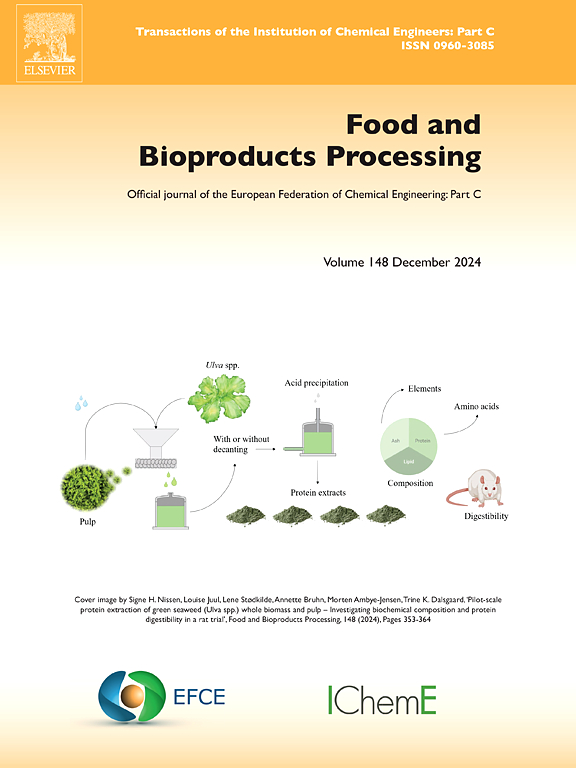意大利普利亚地区橄榄油生产的综合环境分析
IF 3.5
2区 农林科学
Q2 BIOTECHNOLOGY & APPLIED MICROBIOLOGY
引用次数: 0
摘要
对特级初榨橄榄油(EVOO)日益增长的需求和对可持续农业实践的需求强调了评估其生产对环境影响的重要性。本研究使用生命周期评估方法评估了意大利普利亚巴列塔-安德里亚-特拉尼省EVOO生产的环境负担。此外,本研究还考察了对生物多样性丧失和土壤生态系统服务的影响,以提供全面的环境分析。分析了六种情况。农业活动,特别是过度使用化肥(高达77.10 kg N·ha⁻¹)和收获期间消耗柴油(高达7761 kg·ha⁻¹),成为造成环境负担的主要因素。利用副产品(如植被水)的情景对全球变暖、陆地和淡水富营养化等类别的影响较低。利用潜在消失分数量化的生物多样性损失主要是由土地改造而非土地利用驱动的,其中情景A1的影响最大(约3.25·10−11 PDF*年)。在基于土壤的生态系统服务方面,所有情景在土壤侵蚀控制方面表现出相似的表现(55.33 t soil),由于生物量修剪的差异,固碳(4.82-5.40 t C·ha⁻¹)的差异较小。水净化潜力变化显著,氮损失范围为1.01至131.46 kg N,具体取决于施肥制度。这些结果表明,迫切需要可持续农业实践和循环经济战略来减轻环境影响和增强生态系统服务。优化施肥策略和采用替代收获方法可以显著减少环境负担,同时保持生产力和盈利能力。本文章由计算机程序翻译,如有差异,请以英文原文为准。
A comprehensive environmental analysis of olive oil production in Apulia, Italy
The increasing demand for Extra Virgin Olive Oil (EVOO) and the need for sustainable agricultural practices underscore the importance of assessing the environmental impacts of its production. This study evaluates the environmental burdens of EVOO production in the Barletta-Andria-Trani (BAT) province of Apulia, Italy, using the Life Cycle Assessment methodology. Additionally, this study examines the effect on biodiversity loss and soil-based ecosystem services to provide a comprehensive environmental analysis. Six scenarios were analysed. Agricultural activities—particularly excessive fertiliser use (up to 77.10 kg N·ha⁻¹) and diesel consumption during harvesting (up to 7761 kg·ha⁻¹)—emerged as the primary contributors to environmental burdens. Scenarios utilising by-products, such as vegetation water, showed lower impacts in categories like global warming terrestrial and freshwater eutrophication. Biodiversity loss, quantified using the Potentially Disappeared Fraction, was mainly driven by land transformation rather than land use, with scenario A1 showing the highest impact (around 3.25·10−11 PDF*year). Regarding soil-based ecosystem services, all scenarios exhibited similar performance in soil erosion control (55.33 t soil), with minor variations in carbon sequestration (4.82–5.40 t C·ha⁻¹) due to differences in biomass pruning. Water purification potential varied significantly, with N losses ranging from 1.01 to 131.46 kg N, depending on the fertilisation regime. These results highlight the urgent need for sustainable agricultural practices and circular economy strategies to mitigate environmental impacts and enhance ecosystem services. Optimising fertilisation strategies and adopting alternative harvesting methods could significantly reduce environmental burdens while maintaining productivity and profitability.
求助全文
通过发布文献求助,成功后即可免费获取论文全文。
去求助
来源期刊

Food and Bioproducts Processing
工程技术-工程:化工
CiteScore
9.70
自引率
4.30%
发文量
115
审稿时长
24 days
期刊介绍:
Official Journal of the European Federation of Chemical Engineering:
Part C
FBP aims to be the principal international journal for publication of high quality, original papers in the branches of engineering and science dedicated to the safe processing of biological products. It is the only journal to exploit the synergy between biotechnology, bioprocessing and food engineering.
Papers showing how research results can be used in engineering design, and accounts of experimental or theoretical research work bringing new perspectives to established principles, highlighting unsolved problems or indicating directions for future research, are particularly welcome. Contributions that deal with new developments in equipment or processes and that can be given quantitative expression are encouraged. The journal is especially interested in papers that extend the boundaries of food and bioproducts processing.
The journal has a strong emphasis on the interface between engineering and food or bioproducts. Papers that are not likely to be published are those:
• Primarily concerned with food formulation
• That use experimental design techniques to obtain response surfaces but gain little insight from them
• That are empirical and ignore established mechanistic models, e.g., empirical drying curves
• That are primarily concerned about sensory evaluation and colour
• Concern the extraction, encapsulation and/or antioxidant activity of a specific biological material without providing insight that could be applied to a similar but different material,
• Containing only chemical analyses of biological materials.
 求助内容:
求助内容: 应助结果提醒方式:
应助结果提醒方式:


